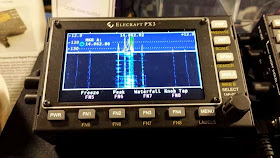Paul Signorelli W0RW posted this to QRP-L yesterday. It is entitled "Top 10 Steps for QRPttF Operation". This is SO good that it needs to be shared with those who might not subscribe to QRP-L. Paul has spent many a year operating outdoors, particularly pedestrian mobile. Paul has a wealth of tribal knowledge built up here and this is good - very good, but often overlooked advice.
Here are the Top Ten Steps that I take for successful QRP Portable operation:
1. Propagation and Band Activity.
When you operate portable you want to work as many people as possible so the band conditions must be good. This means that you have to keep track of the propagation conditions before planning an operation. I try to look for propagation predictions for the band I plan to operate on but they are not very reliable. I check the QSL Net propagation site at <
http://dx.qsl.net/propagation/>
The flux is always changing, so before I pick a date to operate, I monitor the bands at the same time that I plan to operate. The Absorption Index is also a key factor, I never operate when the "A" Index is above 6. I also use the NCDXF beacons see: <
http://www.ncdxf.org/beacon/beaconschedule.html>
Trenton Military (15034 kHz) or CHU (14670 kHz) for 20 Meter propagation checks. Coastal stations might use WWV/WWVH on 10, 15 20 and 25 Mhz.
20 Meters is best for day time country wide propagation. 40 and 80 Meters are good for night time operation. I always try to avoid contests and other busy periods. Checking the QST Contest Calendar helps to insure the band is going to be clear. Check your desired frequency in advance, you don't want to pick a frequency that is used for nets, traffic handling or RTTY.
2. Weather Conditions.
The weather forecasting is really good, so this is easy.
Try <
http://www.wunderground.com/>
I look for warm temperatures and no wind. If it is going to rain don't get too far away from a shelter.
Check your local web cam.
3. Honey Doo Items.
Always check the XYL's honey doo list and make sure you have a valid Pass for the day.
4. Location and Road Conditions.
Try a your local National Park <
http://www.nps.gov/findapark/index.htm>, If you are an Old Timer you can get a lifetime Pass. Always check the road and site conditions before going out in the field. You don't want to drive hundreds of miles to find out that the Capulin Volcano road is closed by snow. Canyon roads can have snow or land slides, Pick an open space operating site, canyons are not good for QRP operating. If you are going to operate Pedestrian Mobile with a whip you will want to find trails that don't have a lot of over hanging, antenna eating branches.
5. Equipment Readiness.
You need to check out your equipment right before you head out to your operating site. This prevents leaving behind some critical item. Needless to say, you should have your antenna all pre-tuned before you leave. My radio is always mounted to a backpack and is always ready to go. The LiIon battery is always charged but I always take a spare. I just need to put the back pack into the car, with the antenna and counterpoise. The accessories should also be checked: microphone, earphones, key, SWR meter, pen, log, watch, hat, gloves, coat, etc.
Make an equipment checklist.
It is good to charge or have a spare accessory batteries for your computer, keyer, SCAF, HT's, etc.,
and a spare radio, clip leads and duct tape for contingencies.
6. Vittles.
I take water, lunch (GORP) and my VHF HT in a fanny pack.
7. Operating Announcements:
I try to post my operations on the reflectors a day before the operation. When
you post too far in advance, people forget and when you post right
before the operation, some people don't get get the notice until after
your are finished. I always try to be on my exact posted frequency (or alternate) at the exact time so people don't get stood up. Posting your operating times gives you more Q's. It is no fun running your battery down calling CQ with no responses. QRPspots, HFnow, GORC, QRP-L, SOTA Summits are good places to list your operation, as appropriate.
Post your schedule in GMT (Universal Time/Zulu time) as well as your local time.
Also post details about your operating location, links to pictures, trail maps, QSL Information, will be helpful, etc.
8. Prep Your Vehicle.
Put gas in your tank !
9. Initial set up.
When I arrive at my operating site, I set up my rig , attach the antenna, and check power and my operating frequency. When operating Pedestrian Mobile, I tune my whip and dragwire, put on my backpack and I am ready for the trail.
10. Safety.
Always be prepared for adverse conditions. You might need rain gear, snake proof boots, a map, GPS, etc. Always give someone your travel plans. Take your cell phone or an HT that will hit a repeater.
Be safe !
------------
For more detailed information on Portable and Pedestrian Mobile operation get WA3WSJ's Amateur Radio Pedestrian Mobile Handbook. He has made his First Edition Handbook free at:
http://w3bqc.homestead.com/W3BQC-Library-Contents.html
That's it, the Top Ten Steps for QRP portable operating. If you are addicted, you can consider this your 10 Step Program.
Paul w0rw
Thanks for sharing your wisdom and knowledge, Paul!
72 de Larry W2LJ
QRP - When you care to send the very least!











